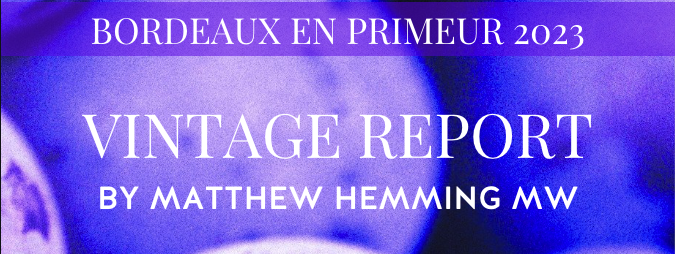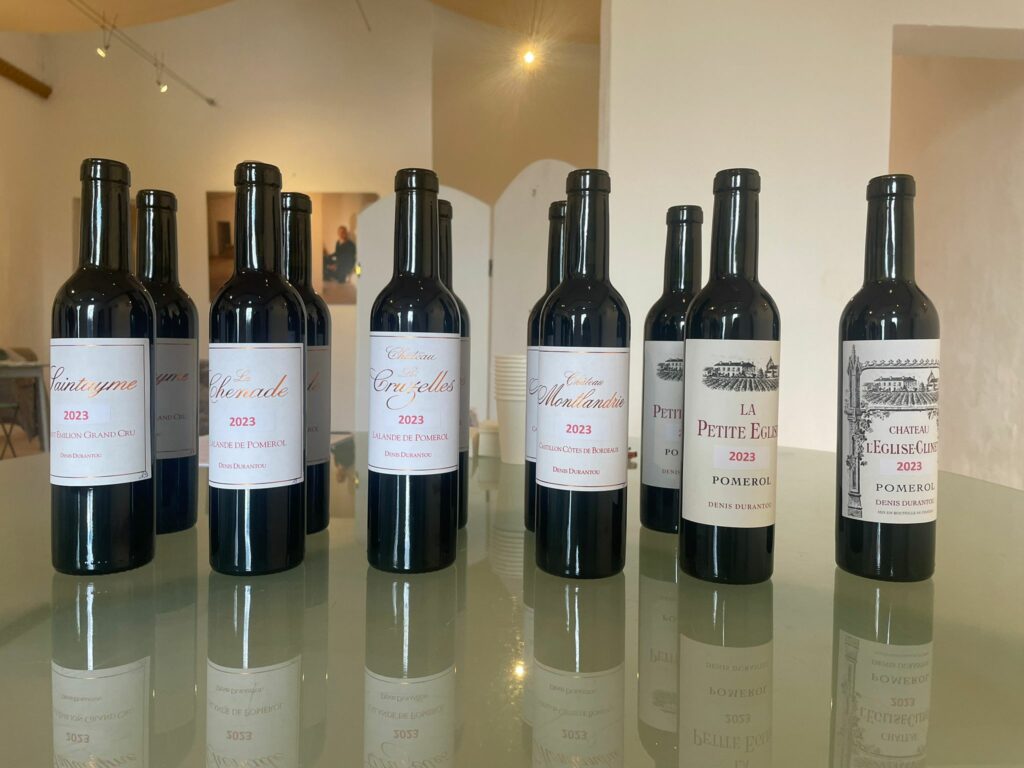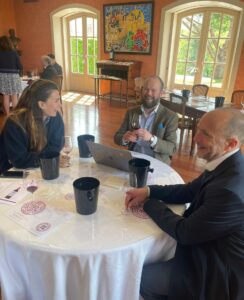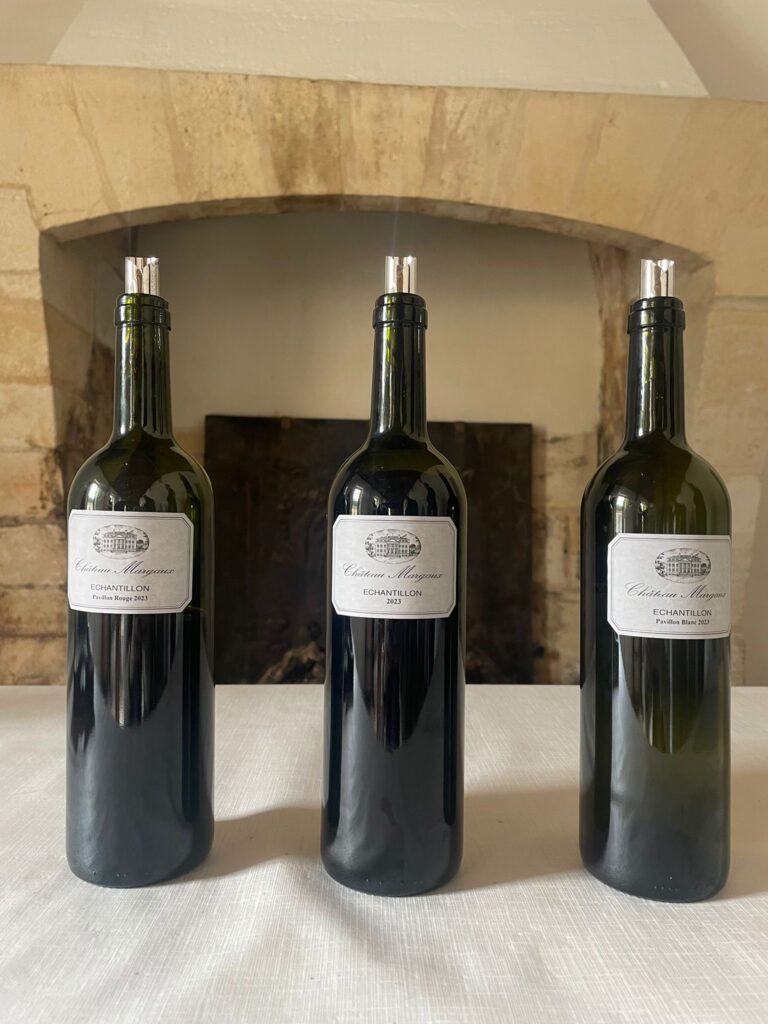

Bordeaux 2023 is a vintage born out of an adversity that stretched from the climatic to market conditions and, beyond wine, to global economic and political woes. Yet, against all the odds, our tastings last week showed that Bordeaux has pulled something pretty special out of the 2023 vat.
In short, I travelled to Bordeaux cynical; I returned enthusiastic and cautiously optimistic.
Vinum is not the merchant to declare 2023 A Great Vintage. It is not in the league of 2019 or 2016 and won’t join the all-time greats. However, more than a few chateaux have produced 2023s promising genuine greatness and many of these I prefer to their 2020 and 2022 incarnations.
In addition, if the stars align – and the Bordeaux astronomers suggest they are moving that way – then 2023 could be a vintage priced for drinkers looking to add top-flight chateaux to their cellars. The optimism I mentioned above is that this might just be a year in which high quality wines from elite producers are widely available and accessibly priced.

“It was like we had two vintages in one,” explained Kelly Moueix when we visited Chateau Belair-Monange, “we saw both the conditions of a wet Atlantic year and those of a warmer solar vintage.”
Vintage reports that read like retrospective weather forecasts don’t often get read to the end, so I will try to summarise the headline factors so we can get to the wine.
About a year ago, in spring 2023, the UK press started publishing doom-laden reports of mildew in Bordeaux. Even on a slow news day, it must be bad for the mainstream media to report on an outbreak of fungal disease in French vineyards and the stories read as though 2023 was already a write off. A result of the damp Atlantic conditions referred to by Kelly Moueix, these reports also contributed towards the climate of negativity which shaped much of the trade’s initial feelings about the vintage.

The humidity that resulted in mildew was the first of two major climatic influences that shaped 2023 Bordeaux. Even before the disease pressure of the mildew, the wet, damp nature of early 2023 had set the scene in the vineyards, creating conditions for vigorous growth and a generous crop. The size of the harvest, with many extremely prestigious estates cropping at more than 40-50 hectolitres per hectare (35hl/ha is considered generous in much of Burgundy) is an important feature of 2023.
Damp conditions persisted through the spring months with temperatures hovering just above average – the combination that delivered mildew sufficient and widespread enough to make the UK newspapers. The theme continued into the summer, with above average humidity, just above average temperatures and overcast skies delivering fewer sunlight hours than most years.
The pattern changed dramatically in late summer. Two heat spikes, in late August and early September, broke the Atlantic weather and introduced the vines to a taste of the solar conditions mentioned by Kelly Moueix as the other side of this Janus-faced vintage.
A period of days in excess of 40c did their bit to dry out the sodden vineyards, bring fruit to ripeness and ease disease pressure. Heat came in combination with a dry period, but the water table was in little danger after the season thus far. Nevertheless, some estates did have issues with fruit raisining on the vine if not properly protected.
It is important to view the heat spikes as spikes and not heatwaves. Heatwaves are sustained through both day and night. Not only did 2023’s late summer heat spikes only last a matter of days but the temperatures eased overnight, providing the plants with relief.
Neither was 2023 a year of one of Bordeaux’s infamous Indian Summers that we all grew used to reading about ‘saving’ otherwise poor vintages that then became labelled as classic. Less of a gently balmy late summer, 2023 delivered more of a short sharp shock that dramatically changed the direction of the vintage. I am also unconvinced that the resulting wines fit any traditional definition of classic – but more of that to come.

“2023 was an extreme vintage without extremes: it started wet but it never actually rained that much; it finished hot but temperatures were never truly that excessive.”
– Omri Ram, Chateau Lafleur & Guinaudeau estates
Omri deftly and characteristically summed up the central paradox of 2023 Bordeaux.
What these conditions did create was a huge amount of work. Producers were pushed almost to the limit and were left exhausted by 2023.
Imagine the period of mildew. You spray your vineyard to protect the crop but, as soon as more rain falls, you need to repeat the treatment as the previous application has been washed away. If you practice organic or biodynamic farming, the vines require even greater attention and care as you are unable to use conventional chemical treatments. Through repetition, and with the ongoing wet conditions, it becomes harder and harder to access your vineyards as tractors start to sink in the mud. Should it rain at the weekend, you needed to spray over the weekend to prevent the mildew taking hold and spreading further. This was sustained through months of humid weather.
The change in weather, when it came, relieved the disease pressure, and hastened ripening, but also introduced the risk of raisined or sunburned berries. This, in combination with a large crop, necessitated a long and meticulous sorting process.
The combination of crop size and the need for forensic sorting meant that most chateaux I spoke with had experienced their longest harvest ever, regularly taking a full month to bring in the crop. Picking was even more protracted for those harvesting on a granular, block-by-block basis as is now popular amongst the best estates. Chateau Pontet Canet’s harvest, for example, lasted twice as long as an average year.
2023 tested producers’ resources, in terms of manpower and material inputs – spraying the 66 hectares of Chateau Palmer’s vines in a timely fashion to combat mildew is not inexpensive. It also tested their resolve and determination to overcome what 2023 threw at them: working on weekends and public holidays, putting in extra days and hours, repeating the treatments again and again…
With these extra challenges piled upon all the regular hands-on viticultural work, you can start to see why those who worked the 2023 found it extreme, even if the analyses of actual rainfall and heat suggest they might have been a bit too close and lost sight of the trees for the forest!

Between the maritime-Atlantic aspects of 2023 and the more solar influences it is something of a Janus vintage, caught between the contrasting qualities of its dual personality. The success of the successful wines was hard-won, as producers struggled against the elements.
Unsurprisingly, the best and most successful 2023s are those where producers managed to harmonise the two facets of the vintage. As ever it is very difficult to capture the style of the wines in a snappy catchphrase and even more so to make meaningful comparisons to previous years.
In broad brush terms, the early part of the growing season gave the wines acidity, low pH values and freshness; the latter, warmer, months ripened the tannins and phenolics without diminishing acidity.
Many people are describing 2023 in terms of being a classic vintage but I think it is better than that. ‘Classic’ has become a descriptor with which to damn with faint praise: I very much like 2004s but they are often described as classic because they are not 2005s.
One chateau owner told us that 2023 is the quality equivalent of 2018 but with a very different personality. 2018’s low acid, warm vintage generosity and richness is totally at odds with the new vintage. But there is no shortage of excellent 2018s and the vintage is unequivocally stronger than 2014, 2017 and 2021 even if it does not match up to 2016 or 2019.
I feel similarly about 2023. It is not a top tier vintage but it is streets ahead of 2021 and a significant step up from 2014 and 2017. Also, as I wrote previously, there are numerous 2023s that I prefer to the same wines in 2020 and 2022 – both of which are regarded as great years by some commentators.
So how do the best 2023s taste?
This is not a fruity vintage. Those seeking Robert Parker’s famous “gobs of sweet fruit” had best look elsewhere. Not to say that the 2023s, at least the good ones, lack fruit or are in any way mean or hollow, they just emphasise other aspects. Rather than being wines dominated by fruit characters, I frequently found 2023s privileging floral and mineral characters.
To return to the subject of so-called classic vintages, they were often savoury rather than fruit-driven. This often meant markedly dry wines showing characters of earth, cigar box and dried tobacco. The 2023s are altogether fresher and more vivid with notes of violets, white flowers, irises and sweet, fresh tobacco.
The freshness and vivid aspects of 2023 are, of course, linked to the vintage’s acidity. The wines generally have lower pH values than most recent years, meaning the higher levels of acidity are more concentrated than usual. As an aside, low pH fixes colour so many 2023s have notably vibrant, purple hues; it will also help preserve the wines in the cellar as they age.
However, where the August and September heat spikes brought the fruit to ripeness, and the winemakers achieved balance, these are wines of marked vibrancy, energy and sapidity without being assertively acidic and certainly not shrill.
As mentioned above, temperatures soared during the days of the heat spikes but the nights were relatively cool. This brought fruit and tannins to ripeness, avoiding green or under-ripe characters, without compromising freshness or leading to excessive sugar accumulation. A result of this is that alcohol levels in 2023 are much more moderate than often seen this century, frequently a full degree below last year and reminiscent of a pre-Parker, pre-global warming era.
In combination, the above factors have yielded 2023s that are relatively slender and linear in profile; they build on the palate with a sort of quiet intensity; benefit from vivid definition, bright acidity and plentiful energy; and finish long, dry and mineral. There is a recurring saline character in this vintage that, like the mineral expression on the nose and palate, I suspect is a function of the acid and low pH.
Without the late season heat, the tannins of 2023 threatened to manifest themselves as green, scratchy and angular because the grapes would have struggled for phenolic ripeness. This sort of structure was detectable in some of the junior and less successful examples of the vintage I tasted. The better wines, however, have a crisply defined and chiselled tannin profile, giving them a mouth-watering crunch and gourmand quality.
In the best 2023s the structure and tannin are easy to miss. The charm, fragrance and sheer juiciness of the wines grabs your attention and only towards the finish do you start to feel the grip. In reality, 2023 is a year of significant tannin – with correspondingly significant ageing potential. Chateau Montrose has a soaring, cathedral-like structure and the Merlots at Brane Cantenac had the highest IPT (tannin index) ever recorded at the chateau.
Having written all that, it is clear that 2023 is not a simple, single-message, easy to understand vintage. On paper, that is. In the glass, these are easy wines to taste and – for lovers of fine Bordeaux, I believe – easy to fall in love with.

In 2023 the mildew alone was sufficient to mean this is not a year of consistent or uniform quality. I did not find identifiable trends or themes within or between the various communes of Bordeaux or even between the grape varieties. At Le Pin, for example, the 100% Merlot was absolutely sensational; at Chateau Lafleur, the 2023 Les Perrieres is 100% Bouchet and this is also thoroughly captivating.
Unable to carve up the vintage by grape variety, bank or commune, I am simply going to highlight two or three personal highlights from each of the major appellations.
Chateau Les Carmes Haut Brion continues to be one of the most singular and distinct wines in all Bordeaux with its high proportion of Cabernet Franc and the signature of whole bunch fermentation. This was our first tasting of the entire trip, at about 0830h, and as such I probably underscored it.
This year I felt Chateau Haut Brion led stablemate La Mission on the basis of subtlety and seamless texture. The urban location of the vineyard has a microclimate that promotes ripeness, so this is larger scaled than the finest vintages but it has undeniable authority and impact.
Chateau Les Carmes Haut Brion 2023
There’s a quality of energy, texture and drive over and above that of C de Carmes (the 2nd wine). More pepper, both from stems and the Cabernet Franc. Has a discreet but assured scent and insistence. Just the slightest hint of toast. Very complete, spherical and seamless. Nothing showy. Has a saline twist on the back end. Compact and silky.
93-95pts
Chateau Haut Brion 2023
More discreet and fine-spun than Mission, this is more subtle and complex. The tannins have a quiet build but crescendo to something quite significant. Lovely, dry, savoury texture. Superb length and drive. A little too powerful to be elegant. Salty, tangy finish.
94-96pts

We tasted more Saint Emilion than we did wines from any other commune yet I still have a long list of others I wish I had been able to try. Such is the excitement around the resurgence of this appellation, and the wines I did taste absolutely delivered on that. It continues to be a heterogenous vineyard area, with no single identity, but the winemakers do seem to have returned en masse to making wine that speaks of their respective vineyards and not of their wineries. In 2023 the quality of the best limestone terroirs sang forth clearly.
My scores show a tie for first place between Chateaux Cheval Blanc and Figeac, both with the same score, with Beausejour Duffau, Belair Monange and Canon sharing the number two spot.
Chateau Cheval Blanc 2023
Fragrant and floral – violets, spice and pepper. Very fine-spun on palate. Fresh, delicate and silky. Dry but without being assertively so, this is saline and complex. Long and fine-boned.
94-96pts
Chateau Figeac 2023
41% Merlot, 32% Cabernet Franc, 27% Cabernet Sauvignon. Beautiful, gourmand, Cabernet profile. Leafy, creamy, blackberry and blackcurrant fruit. Cool and with a touch of mint. Controlled decadence. Fresh, with very clean lines, touch mineral, graphite tones. Some floral aspects on the back of the palate. Finishes with spice and pepper.
94-96pts
Chateau Belair Monange 2023
Rich, sweet and ripe with lots of succulent berry fruit. Tight and saline with a very marked limestone character. Taut and mineral. Glossy, generous tannin with a fleshy covering of fruit. Luxurious. Built like a racehorse.
93-95pts
Chateau Beausejour Duffau 2023
Has 35% Cabernet Franc giving spice and complexity. Lovely mid-palate weight, energy and crunch, with spice and nuance. Classical, fresh and lifted. Elevated floral elements, purity and perfume. Delicate blackberry scent on the finish.
93-95pts

Two of my very favourite wines of the vintage came from Pomerol: Chateaux Lafleur and La Conseillante. Tasting dispassionately – insofar as that is possible – I had Le Pin, Vieux Chateau Certan and La Fleur Petrus on a qualitative par with La Conseillante. However, it was that last wine that etched itself in my memory as one of 2023’s true stand outs.
NB – if you are offered an allocation of Les Perrieres 2023, the the Guinaudeau family of Lafleur, grab it with both hands. It is brilliant.
Chateau Lafleur 2023
54% Bouchet, 46% Merlot. Lilacs, iris, violet and fresh tobacco. Very fragrant. As ever, totally unique and thrilling. Super clean lines, cleansing and savoury. Has build and thrust. There is an inner sweetness and perfume but without any sugar impression. Fnishes soaring and mineral.
96-98pts
Chateau La Conseillante 2023
88% Merlot, 12% Cabernet Franc. 42hl/ha. Stunning aromatics, with all the best floral qualities of Pomerol in 2023. Fragrant, blossom-scented and elegant from the nose and sustained right through the line. Lilacs, tobacco and spice. The profile is slender and svelte. Fine-boned and delicate. Tannins are finely-sculpted and show real finesse. Has spice, energy and vibrancy.
95-97pts

There is an unusually high level of agreement that Chateau Montrose is amongst the wines of the vintage in 2023. Today the estate seems to have left the rest of the super second growths standing and it performs like a de facto 1st growth.
Tasting Cos d’Estournel after Montrose was perhaps unfair, as it was an extremely difficult act to follow. If you looked carefully, however, Cos 2023 is a wine of surprisingly under-stated class and finesse – worlds away from the blockbuster style of the past.
I also want to mention Chateau Les Ormes de Pez. The Cazes family, of Lynch Bages, must have poured significant care and attention into this property in recent years given the uptick in quality. This is not a grand wine, and will be priced at a much lower order of magnitude than the others I mention – it may be a very canny buy.
Chateau Montrose 2023
75% Cabernet Sauvignon. Starts out slowly but has that classic Montrose build and the monumental tannins that develop through the mid-palate. Driving and mineral, with a saline edge and plenty of spice. The nose needs more time to evolve but the freshness, purity and floral aspects of the palate are superb. Finishes with blackcurrant leaf and a hint of mint and pepper. There is a very sophisticated seamless quality to the profile. Has masses of class and could become something very special in time.
94-97pts
Cos d’Estournel 2023
Nose a bit closed but with esturine and marine notes of sea spray and even oysters. Tight red fruts on the palate, with saline accents and a mineral seam. There’s spice, energy and impressive line. Oak is almost invisible. Surprisingly fine-grained and vigorous.
93-96pts
Chateau Les Ormes de Pez 2023
Very classy nose – cassis and damson fruit, walnut skin and cedary oak. Floral, supple and spicy. Tannins are substantial but sit within the wine.
91-93pts

For my palate, Pauillac displayed the greatest concentration of quality wines in the Medoc, and maybe in all Bordeaux, in 2023. The question becomes, how many wines can I mention whilst retaining any credibility?
The shortlisted chateaux with notes below speak for themselves, but this is only part of the story. Whilst Mouton is technically my pick of the appellation, I adored Pichon Lalande and would put it as one of my wines of the vintage – it was viscerally thrilling to taste and number two only to Chateau Margaux in terms of my personal preference.
Pichon Comtesse Reserve – the new name for Reserve de la Comtesse – must now be the equal of the Grand Vin in vintages like 2001 and 2004. It is that good.
Chateau Grand Puy Lacoste is probably my favourite Medoc estate and this year I rated it on a par with none less than Lafite – which I though positively oozed class. Lynch Bages was just a nose behind and has everything you could ever want from this much-loved chateau.
They will never normally get mentioned in a fast-paced commentary like this, but the entire Mouton-Rothschild stable is worth a close look in 2023. Petit Mouton is now probably the highest quality second wine of any of the 1st growths, with the possible exception of Les Forts de Latour (but not in 2023). Chateau Clerc Milon is the equal of Pichon Baron for me this year and d’Armailhac delivers classic, lively Pauillac.
Phew – I will treat myself to four Pauillacs.
Chateau Mouton-Rothschild 2023
Rich and slightly smokey, but not an oak character. Cool, sweet and driving on the palate. Quite a discreet Mouton – very controlled and proportioned. Dry, mineral and sophisticated. Much more tannic than you initially think, but they’re beautifully scuplted.
95-97pts
Chateau Pichon Lalande 2023
Very pure – crystalline – and floral with complex perfume of violets and lilies. Stunning aromatics, set off by a hint of wood toast and savoury reduction. Almost nodding towards Vosne in its scent. Graphite and tobacco come with air and the texture is extremely fine-grained and silky. Outstanding finesse and filigree tannins. One of the high points of the Medoc.
94-97pts
Chateau Grand Puy Lacoste 2023
Bang on Pauillac expression of ripe blackcurrant and cassis alongside something fresh, mineral and graphite-scented. Has cedar and tobacco. Lifted and with super-clean lines and marked finesse. Already tastes complete. Impressive complexity and juicy brightness.
94-96pts
Chateau Lynch Bages 2023
Really fine and impressive. Has the classical tannin structure, power ad intense blackcurrant. Powers through the mid-palate with dusty earth, cigar box and cassis. Dry, mineral and punchy finish. Has a stony, mineral, saline character at the very back end.
93-96pts

I missed tasting a couple of major Saint Julien chateaux this year, notably Leoville Las Cases but, from my notes, it does appear that the commune is slightly off key, not as consistently high quality, this year.
That said, Chateau Leoville Poyferre put in a typically stylish showing, somehow managing to be very glamorous with hardly any obvious artifice – a neat trick. Experience has shown me how Gloria over-delivers again and again at in-bottle tastings. This chateau is one of the great values of the Medoc, at the right price I urge every buyer of the vintage to take a case of magnums.
Chateau Leoville Poyferre 2023
As ever, very stylish without being stylised. Glossy, sweet tannins framing very pure cassis fruit. Dark-toned without being pushed too far. Very impressive poise, balance and proportion. Spice, pepper and graphite on the mineral-accented finish.
94-96pts
Chateau Gloria 2023
Violet-scented and elegant. Savoury fruit profile with a sweetness of perfume. Very engaging balance and lovely sense of fluidity.
91-93pts

We draw to a close with my favourite 1st growth of 2023 and the wine that ties for top honours of the vintage with Chateau Lafleur: Chateau Margaux. Often a wine I struggle to love, the 2023 Chateau Margaux is utterly captivating.
My other pick from Margaux is Chateau Brane Cantenac, an estate consistently delivering a super second growth experience for a very fair price. The 2023 has a filigree texture married to a purity of blackcurrant that is almost more northern Medoc in profile. I believe this goes toe-to-toe with Palmer in this vintage.
Chateau Margaux 2023
89% Cabernet Sauvignon. Sweet, scented fruit, bolstered by some oak sweetness. Extremely fine and delicate texture with a structure that sits in the background until you notie the acidity singing through and feel the tensile tannin framework on the finish. Perfumed and aromatic through the mid-palate. Exquisite balance and finesse.
96-98pts
Chateau Brane Cantenac 2023
Discreet but classic nose of surprising richness and concentration. Spice, blackcurrant and cassis. Very pure Cabernet tones – graphite, smoke and earth. Mid-palate texture is fine-spun, delicate and more classically Margaux.
93-95pts
